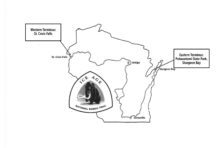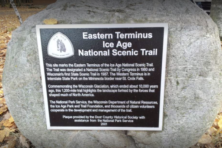Ice Age Trail Becomes Part of National Park System
- Share
- Tweet
- Pin
- Share

A decade-long attempt to fold the Ice Age Trail into the National Park Service system finally succeeded.
The Ice Age, New England and North Country National Scenic trails have become the 426th, 427th and 428th units of the National Park System, said National Park Service Director Chuck Sams during a press conference, Dec. 7.
Sams said the designation makes the trails eligible for National Park Service (NPS) resources, including access to NPS funding for improvements. The trail systems will also now appear in NPS brochures, listings and promotions. U.S. Sen. Tammy Baldwin (D-Wis.), appearing remotely for the press conference, said the NPS unit designation will also establish administrative clarity.
“It puts us on the map – literally,” Baldwin said.
The Ice Age Trail (IAT) is a 1,200-mile-long trail stretching from northwest Wisconsin at the St. Croix River to Door County’s Potawatomi State Park. The glaciers left behind terrain, lakes and geology that make the IAT a landmark in locations throughout the state, Baldwin said.

“Along those hundreds of miles, local businesses, families, outdoor enthusiasts and communities reap the benefits, as visitors from all over come to enjoy Wisconsin’s great outdoors,” Baldwin said.
Destination Sturgeon Bay Executive Director Cameryn Ehlers-Kwaterski can attest to the influence the trail has on the City of Sturgeon Bay, which became an Ice Age Trail community in August 2020. She said it’s remarkable how many people use the city as a base for hiking IAT segments or who walk the entire IAT, starting or ending at Potawatomi.
“It is a really important component of our visitor demographic,” Ehlers-Kwaterski said.
Baldwin said she had lobbied for the past decade for NPS designation for both the IAT and the North Country Scenic Trail, which passes through northern Wisconsin on its meandering 4,800-mile track from Vermont to central North Dakota.
Baldwin said she was driving in a car with assistants when she heard that the trails had received the designation. She quickly pulled up the trail on her phone and looked for the first IAT trailhead and then pulled off the road to celebrate there.
Another person also celebrating is Ice Age Trail Alliance Executive Director Luke Kloberdanz. He said unit status gives the trail, and its volunteers, the recognition it deserves.
“At last, the Ice Age Trail, North Country Trail, and New England Trail are on equal footing with other National Scenic Trails and National Parks,” he said.
Other trail proponents nationwide have sought NPS unit status, but Sams emphasized the massive volunteer efforts that support these three trails in particular – more than 150,000 hours during the past year.
IAT volunteerism led the pack. Volunteers donated a record 100,666 hours to the IAT this year, Kloberdanz said. He said those volunteer hours donated would rank among the top 10 totals for units in the national park system.

Volunteers work at moving and setting blocks for steps on the Ice Age Trail at its eastern terminus within Potawatomi State Park. Photo courtesy of Bob Jorin.
IAT volunteer efforts this year were highlighted by a rendezvous and encampment of volunteers who spent a week rerouting and building stone steps at the eastern terminus of the trail in Potawatomi State Park.
Bob Jorin of Sturgeon Bay leads an urban history and bayside walk for the Ice Age Trail Alliance once a year, since he knows and enjoys the off-trail, sidewalk portions of the IAT route. He travels to trailwork days every year and also camped and volunteered at the blitz at Potawatomi this summer.
Jorin said the trail has worse connectivity issues – with IAT thru-hikers needing to walk for miles alongside or on busy roadways in some stretches – in counties other than Door. He identified the only stretch like that in Sturgeon Bay as a half mile on Neenah Avenue through the industrial park to the Ahnapee Trail. Jorin said he’d love to see more uninterrupted, off-road trail in many parts of the state, and fewer on-road connecting routes.
“I think anything that draws attention and draws more hikers is good for the trail and for Wisconsin,” Jorin said.
During the announcement press conference, Kloberdanz said there are “lots” of missing links in the trail but many more miles of trails through scenic areas and wilderness.
Designated as a National Scenic Trail in 1980 by President Jimmy Carter, the Ice Age Trail was one of 11 National Scenic Trails in the country, six of which were administered by the NPS. Of those six, three trails (Appalachian Trail, Natchez Trace Trail, and Potomac Heritage Trail) were identified as units at the time of their designation. This specification was missing from the wording of the law when the Ice Age Trail, North Country Trail, and New England Trail were designated.
Non-designation had real-world implications for the trails, including funding opportunity restrictions. It also meant the Trails were not recognized as part of the NPS.
“It was quite confusing,” Kloberdanz said. “On one hand, NPS is our administrative partner helping to create the Ice Age Trail. Alliance volunteers go through NPS-required training and report their volunteer hours to NPS. But on the other hand, the Ice Age Trail was not allowed to enjoy the same benefits as other units of the Park Service.”



